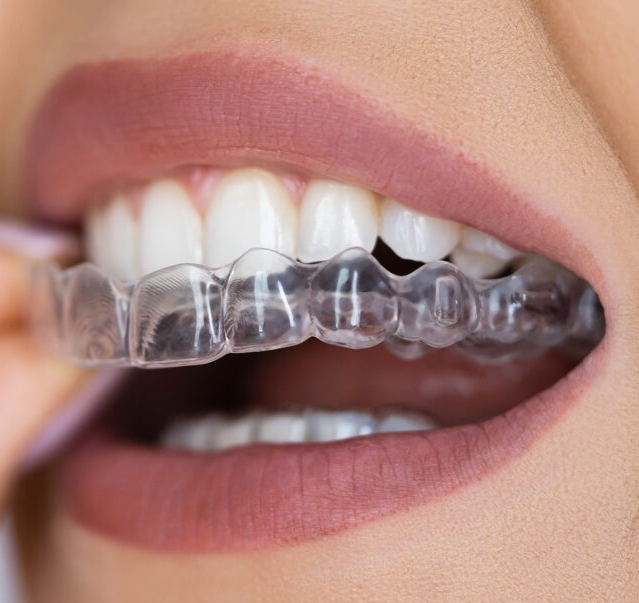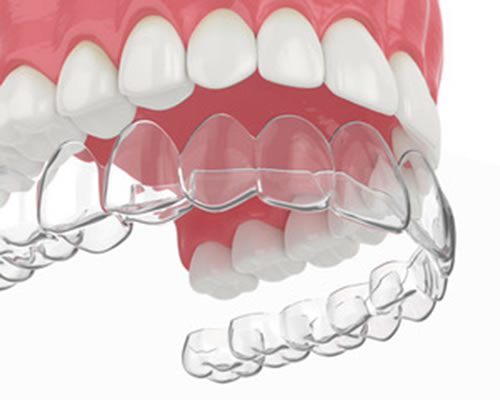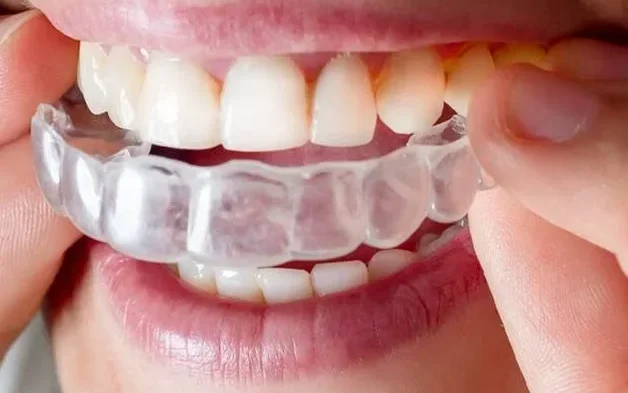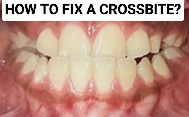Invisalign is a popular orthodontic appliance that a lot of people choose for teeth straightening. This alternative to traditional braces uses invisible aligners made of clear thermoplastic materials that are custom-designed to fit each person’s teeth. With Invisalign, people can achieve straighter teeth without the need for metal brackets and wires.

HOW DO CLEAR ALIGNERS WORK?
Clear aligners work by using a series of clear, removable aligners that gradually move the teeth into the correct position. Each set of aligners is worn for a specific period, usually two weeks, before being replaced with the next set. Invisalign aligners apply gentle pressure to the teeth, which gradually moves them into the desired position over time. The treatment plan is based on a custom-made 3D model of the patient’s teeth, which is created using advanced computer software. This allows the orthodontist to accurately plan the movement of each tooth and determine the number of aligners required for the treatment.
ADVANTAGES OF CLEAR ALIGNERS
1. Discreet treatment: One of the main advantages of Invisalign is their discreet design. The aligners are made of clear, transparent materials that are virtually invisible. People can straighten their teeth without the noticeable metal braces, and hardly anyone will notice that they are wearing them.
2. Comfortable: Invisalign aligners are made of smooth, high-quality materials that don’t irritate the mouth or gums. There is no poking of wires, no uncomfortable brackets, and no rubber bands to deal with.
3. Hygiene: Invisalign aligners are removable. This makes it easy to keep the teeth clean and free from bacteria and food particles. Traditional braces can be challenging to brush around, increasing the risk of tooth decay.
4. Fast Results: Depending on the complexity of the treatment, the average time for Invisalign treatment is between 12 and 18 months. This makes it a faster method for teeth straightening, especially in comparison to traditional braces.
5. No Dietary Restrictions: Invisalign aligners can be removed during mealtimes, which means there are no dietary restrictions. This is different from traditional braces in which certain foods and drinks must be avoided altogether.
DISADVANTAGES OF CLEAR ALIGNERS
While clear aligners have many advantages, there are also some potential disadvantages to consider, including:
1. Cost: Clear aligners tend to be more expensive than traditional braces, particularly for more complex cases.
2. Self-Discipline: Clear aligners need to be worn for a minimum of 20-22 hours per day, which means that patients really need to be disciplined about wearing them as directed.
3. Compliance: Clear aligners require a lot of compliance from the patient. Unlike fixed braces, which remain in place for the duration of the treatment, clear aligners must be removed from the mouth when eating, brushing and flossing. Patients who frequently forget to replace their aligners after eating or drinking may experience slower progress.
4. Limited effectiveness for complex cases: Clear aligners are typically recommended for mild to moderate cases of misaligned teeth. Patients with more complex orthodontic problems may not be able to achieve the desired results with clear aligners alone.
5. Discomfort: Patients who are beginning to wear new aligners or are on the early stages of treatment may experience some discomfort and soreness as the aligners gradually shift the teeth.
It’s essential to consult with a reputable orthodontist or dentist to determine whether clear aligners suit your dental needs. They can help you weigh the potential advantages versus the disadvantages and decide if clear aligners is the right treatment option for you.

WHAT IS THE PROCESS OF GETTING CLEAR ALIGNERS?
The process of getting Invisalign usually begins with an initial consultation/evaluation with an orthodontist. The orthodontist will examine your teeth and bite, and determine if you are a good candidate for Invisalign. A 3D digital scan or impressions will then be taken of your teeth to create the customized treatment plan. The customized treatment plan involves creating a digital image of the movement of each tooth, which will be used to create the plastic aligners. Once the digital treatment plan is complete, you’ll be fitted with your first set of aligners that will gradually move your teeth. As you progress through the treatment, you’ll need to wear each set of aligners for about two weeks before moving on to the next.
Clear aligners are custom-made, removable orthodontic appliances that are designed to gradually move teeth into their desired positions. The procedure for clear aligners typically involves the following steps:
1. Consultation:
The first step in the clear aligner process is a consultation with an orthodontist or dentist who specializes in orthodontic treatment. During the consultation, the orthodontist will assess the patient’s teeth and bite, and determine if they are a good candidate for clear aligners. They will also discuss the patient’s goals and expectations, and review their treatment options.
2. Treatment planning:
Once the patient has been approved for clear aligner treatment, the orthodontist will take digital scans or impressions of their teeth, which will be used to create a 3D model of the patient’s mouth. The orthodontist will then use this model to develop a custom treatment plan that outlines the specific movements of the teeth over the course of treatment.
3. Aligner fabrication:
Once the treatment plan has been developed, the aligners will be fabricated using state-of-the-art 3D printing technology. Each set of aligners is custom-made to fit the patient’s mouth and is designed to gradually move the teeth into their desired positions.
4. Wearing the aligners:
The patient will be instructed to wear the aligners for approximately 22 hours per day, only removing them for eating and brushing and flossing. The patient will typically wear each set of aligners for two weeks before moving on to the next set in the series.
5. Monitoring progress:
During treatment, the patient will have regular appointments with their orthodontist or dentist to monitor progress and ensure the aligners are working as intended. The orthodontist will make any necessary adjustments to the treatment plan to ensure the best possible results.
6. Finishing treatment:
Once the final set of aligners has been worn, the patient may need to wear a retainer to prevent their teeth from shifting back to their original positions. The orthodontist will provide instructions on how long to wear the retainer and how to properly care for it.
Overall, the clear aligner process is designed to be convenient and efficient, with minimal disruption to the patient’s daily routine. By following the treatment plan and wearing the aligners as directed, patients can achieve a straighter, healthier smile in a relatively short amount of time.
COST OF CLEAR ALIGNERS
The cost of clear aligners can vary widely depending on several factors such as the severity of the patient’s dental issues, the length of treatment, the brand of aligners, and the location of the orthodontist.
On average, the cost of clear aligners ranges from $2,000 to $8,000. However, some cases may cost significantly less or more than this range.
It is important to note that clear aligners are often more expensive than traditional metal braces, but they do tend to be more discreet and comfortable. Additionally, some dental insurance plans may provide coverage for clear aligner treatment, which can help offset the cost.
Patients should consult with their orthodontist or dentist to determine the exact cost of clear aligner treatment and discuss any payment options that may be available. Some providers offer financing plans, payment plans, or discounts for paying in full upfront.

Who is a Good Candidate for Invisalign?
Invisalign is suitable for most people, but there are some cases where traditional braces may be more appropriate. Invisalign can be used to treat mild to moderate teeth crowding, spacing, bite issues, and mild to moderate orthodontic relapse. To determine if Invisalign is right for you, a consultation with an orthodontist is the first step.
Wrapping up,
Invisalign is an excellent alternative to traditional braces for people who desire a discreet, comfortable, and convenient teeth straightening option. Invisalign aligners are invisible, comfortable to wear, and removable for brushing and cleaning. If you’re interested in Invisalign, consult an orthodontist to determine if it’s right for you.
FAQs
Here are some frequently asked questions regarding clear aligners:
1. What are clear aligners?
Clear aligners are custom-made, removable orthodontic devices which are worn over the teeth to align and improve bite issues.
2. How long does it take to complete clear aligner treatment?
The length of treatment differs for every patient and their specific needs. Usually, treatment can take anywhere from 6 months to 2 years, depending on the case.
3. Can I eat and drink normally with clear aligners?
It is recommended to remove the aligners during eating and drinking to avoid staining and damage to the aligners.
4. How long do I wear clear aligners for every day?
It is suggested that you wear your clear aligners for a minimum of 20 to 22 hours per day to ensure progress.
5. Can I brush my teeth with clear aligners on?
No, it is recommended to remove the clear aligners before brushing your teeth to ensure thorough cleaning.
6. Can I still play sports or a musical instrument while wearing clear aligners?
Yes, clear aligners are removable, so you can take them out for sports and playing musical instruments. However, you should wear a mouthguard while playing sports.
7. What are some of the brands of clear aligners?
There are several brands of clear aligners on the market, but some of the most well-known ones include Invisalign, ClearCorrect, and Smile Direct Club.
8. Are clear aligners painful?
At the beginning of treatment, some patients may experience some pressure or discomfort while getting used to their aligners. However, this discomfort should subside within a few days or weeks.
9. Who can use clear aligners?
Clear aligners can help treat a variety of orthodontic issues, but they are typically recommended for mild to moderate cases. It’s best to consult with your orthodontist or dentist to determine whether clear aligners are right for you.
10. How frequently do I need to schedule appointments with my orthodontist during clear aligner treatment?
Patients will likely need to schedule appointments with their orthodontist every 4 to 6 weeks during clear aligner treatment to monitor progress.




One thought on “What Are ORTHODONTIC CLEAR ALIGNERS (INVISALIGN)?”